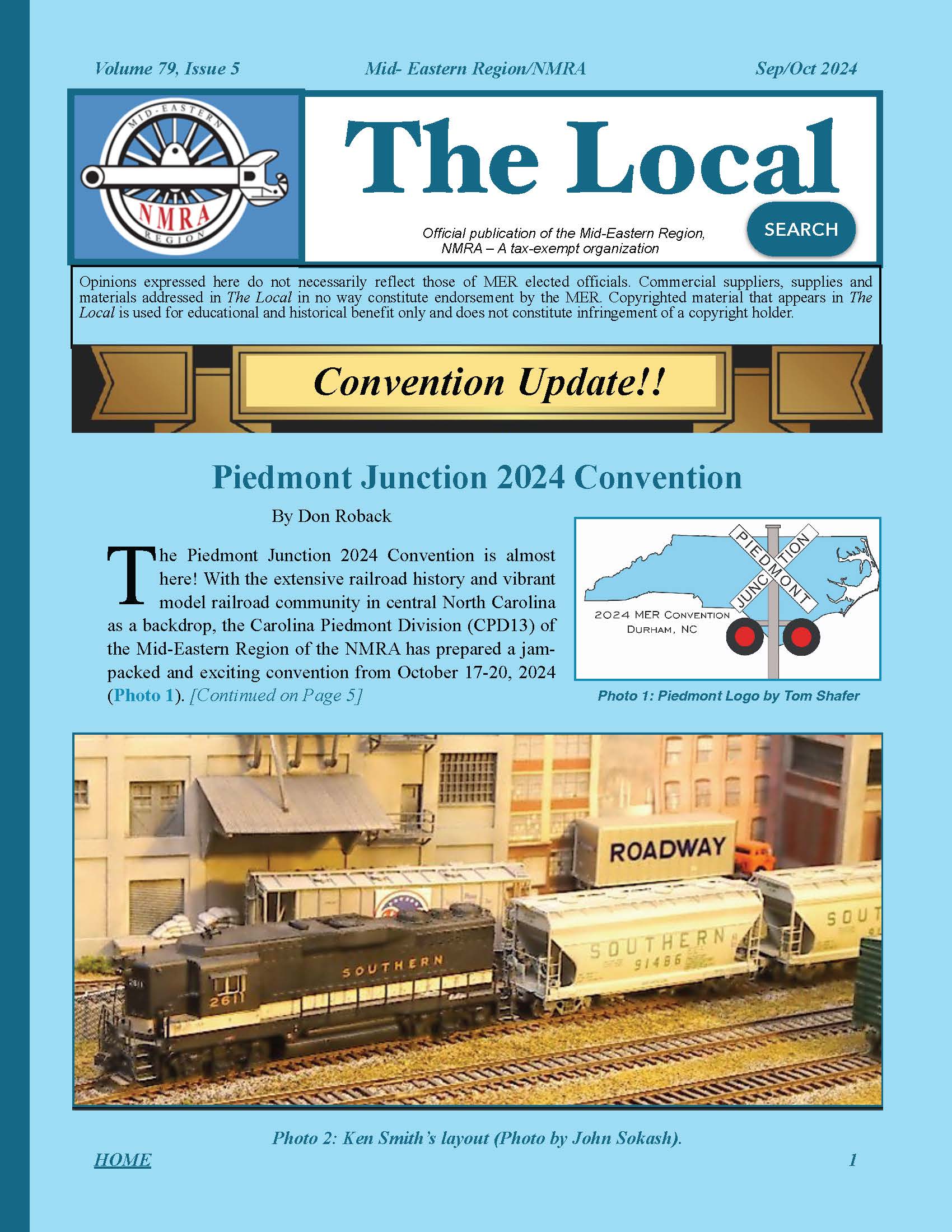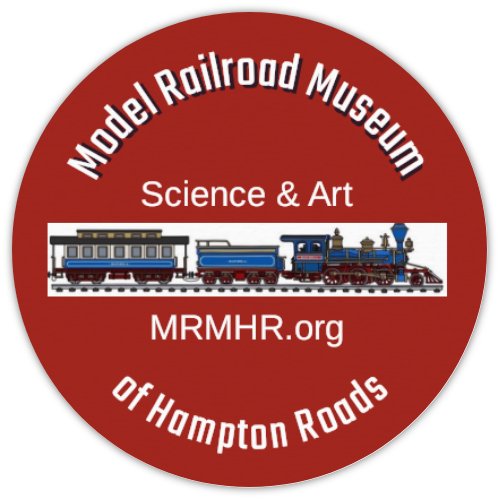Making Tracks
September 2024
Making Tracks September 2024
Contents:
- Holiday Display on November 15
- Lancaster and Warrington Collections by Warren Leister
- Vintage and Scarce Wooden Track Trains, by Dave Pecota
- New Tracks Modeling - Scholarship Winners
- The Art of Model Railroading
- The Local
- Video of the Month
Holiday Display Opening
November 15, 2024 !

Second Floor, MacArthur Center
Volunteers welcome: Sign up here!!
The Lancaster Collection
By Historian Warren Leister
{Author's notes are in brackets and italics}
Exclusively Written for Making Tracks September 2024:
From the Suffolk News-Herald dated February 17, 1996 titled "Arthur Lancaster Jr. Passes On, 'Junie' has left a legacy of friends, accomplishments," By Marilyn Panton Staff writer.
"'Mr. Lancaster, your trains sure do make me happy!' beamed the little boy as he tugged on the coattails of the gentleman at an elaborate model train display, worth well over a million dollars."
"But it wasn't the monetary value of the train collection nor the fact that he owned it which made the man happy. It was the fact that a child had been well pleased."
"'It's what made it all worthwhile to Junie,' said his nephew John Lancaster, vice president of Bennett's Creek Wholesale Nursery, Inc. 'He loved people of all ages but he had a keen interest in children. Wherever he went and whenever you saw him, he always had a kind word to say and a smile on his face.'"
"That is only a part of the legacy of the late Arthur James 'Junie' Lancaster Jr.. 77, who passed away quietly in his sleep at his home in Suffolk on Thursday afternoon, Feb. 15, 1996."
"What were some of the other components of this man who, in spite of his astronomical wealth, would greet people in his brown work clothes and red suspenders, working just as hard as the next fellow at Bennett's Creek Wholesale."
"Said John Stone, executive director of the Maryview Foundation, 'When I met Junie that day, I don't know what I expected, but I met a very friendly, warm and wonderful human being, probably one of the greatest people I've ever met who was in his work clothes, driving a tractor and picking up the trash. He was just a remarkable person.'"
"No matter what area of life Lancaster was involved, he was just that involved. 'Even when Junie was really (physically) weak. he was stronger than most people are on a normal day,' said G. Robert Aston, president and CEO of Commerce Bank. 'The amount of business he generated, his attitude toward his employees and the things he did in a humanitarian way with everyone was incredible.'"
"'I've never met anyone in my life who had all of his characteristics and attributes, 24 hours a day, seven days a week. Junie had a special and very unique quality,' Aston added. Wayne Sawyer, president of Bennett's Creek Wholesale Nursery, Inc. and longtime friend and associate of Lancaster's, said, 'His main driving force was people. Some people want to make money. Junie wanted to bring people out and bring people together.'"
"Echoed John Lancaster, 'He loved people probably more than anything in the world. Whenever you saw him, he always had a kind word and smile on his face. One thing that really stands out is that even when Junie got upset, he always ended up with a smile on his face.'"
"Lancaster and his wife, Mildred Lee Snyder Lancaster, manifested his and their generosity in many ways and to many organizations throughout his lifetime."
"It was because of Lancaster that there is a Bennett's Creek Rescue Squad. He became a diligent organizer of this effort when a car wreck on Rt. 17 resulted in a lengthy time lapse in getting an ambulance on the scene. He energized and involved the Ruritans and in 1970 got the effort off the ground."
"It was because of Lancaster that there is a Spiritual and Educational Center at Maryview Nursing Home Center. The fact that it is named in his honor was probably inconsequential to 'Junie.' The fact that it got built was not.
"'Junie was able to come to the dedication on Oct. 31. 1995,' said Stone. 'Millie said that it was the happiest day of their lives to see this project come to fruition. Thank God, he was there to see it happen.'"
"It was because of Lancaster that the Holiday House of Portsmouth was able to add the Ziegler Recreation and Therapy Building several years ago to augment the services to severely and profoundly challenged youngsters."
"And, it is because of Lancaster's death that the annual Valentine Tea for the Holiday House has been canceled for tomorrow in his memory and honor. 'He was the most delightful person.' said Executive Director Lois Ziegler. 'Everybody at Holiday House loved him. He will be greatly missed.'"
"It was because of Lancaster that Aston went forward with his plans to begin what is now known as Commerce Bank. 'When I got ready to start Commerce, Junie was really the first one I went to see if he was interested in coming with me to help me do it. As usual, he was ready to go at a moment's notice,' said Aston. 'I think when I look at the success of Commerce Bank, I don't think there is any one person who has contributed more to our success than he did.'"
"It was because of Lancaster that numerous of his employees benefited from his own expertise, generosity and faith in his fellow human kind by being placed in positions of responsibility, administration and even ownership of the four businesses of which he was either founder or involved: Bennett's Creek Wholesale Nursery, Inc., Mike's Trainland. Lancaster Farms Wholesale Nursery, and Coleman's Nursery."
"'It has been employees and others who are generally no relation to him that he involved, trained and wanted to see succeed,' said Sawyer."
"John Lancaster added, 'That was one thing he did with all of his businesses. He turned them all over or sold them all to employees who have worked for him. And he made it possible for them to do it.'"
"It was because of Lancaster that children of all ages enjoy the Christmas Wonderland at Coleman's Nursery each year. Lancaster started the tradition that has escalated into a veritable extravaganza of color and lights that people from throughout the entire state and beyond come to enjoy."
"And, it is because of Lancaster and his generosity that the Children's Museum in Portsmouth is the recipient of that million dollar train collection."
"There might not be another chance for a little child to tug directly on Junie Lancaster's coattails, but it is almost a sure thing that when a child smiles at those trains, Junie Lancaster will somehow know about it."
Another article from the Suffolk News-Herald dated February 17, 1996 titled "Arthur Lancaster Jr. Passes On, Generosity shown in countless ways," By Marilyn Panton, Staff writer:
"Arthur J. 'Junie' Lancaster, Jr., 77, died quietly in his sleep between 1:30 and 2 p. m., Thursday afternoon, Feb. 15, 1996."
"His quiet death left a legacy that will speak in perpetuity to people of all ages, cultures and diversifications."
"The far-reaching effect of 'Junie' Lancaster's life began when he worked for the Virginian Railroad shortly after he came back from service in World War II."
"That's the time during which he 'fell in love' with trains. However, he also had a sincere appreciation of horticulture and grew azaleas as a hobby in his backyard. He subsequently began selling those plants to the then owner of Coleman's Nursery, John Coleman."
"A friendship forged and Coleman offered Lancaster a job. In 1951, Lancaster began what was to be an illustrious career in horticulture at the famed nursery in Portsmouth. 'He was a grower.' said Lancaster's nephew John Lancaster, vice president of Bennett's Creek Wholesale Nursery, Inc. 'He really had a green thumb.'"
"But his love for trains never abated. 'When Junie went to Coleman's and got into a position that he could do it, he began to purchase model trains,' said Wayne Sawyer. president of Bennett's Creek Wholesale Nursery, Inc."
"In the late 1950s Lancaster purchased property in old Nansemond County which he subsequently developed into Lancaster Farms. However, in the late 1960s at Coleman's death, Lancaster became the owner of Coleman's Nursery."
"He began Bennett's Creek Wholesale Nursery in 1974 and was president of that corporation until 1993."
"During that time, he decided to establish a location for that train collection that continued to grow and, in 1983, established Mike's Trainland and The Lancaster Old Toy and Train Museum."
"When Lancaster retired because of the physical challenges he was facing due to Parkinson's Disease, he was still quite mentally alert."
"Said John Stone, executive director of the Maryview Foundation, on which Board Lancaster served for several years, 'Even after he became ill, he still wanted to attend the Board planning conferences and take an active role. He was of great assistance to us, even recently.' Rev. Raymond Edmonds, pastor of the Monumental United Methodist Church in Portsmouth, said of his parishioner, 'He was always active even when he was incapacitated. He had such a spirit to live to give. He was a very generous person and not just with his finances. He was generous in all ways, just a tremendous person. Since I have been pastor here. I have never seen him 'down.'"
"Edmonds said that just this past Tuesday, Lancaster had inquired to ensure that his nurse order flowers for Valentine's Day for his wife of 53 years, Mildred Lee Snyder Lancaster."
"His energy and organizational abilities flowed through numerous projects that bear his mark: the establishment of the Bennett's Creek Rescue Squad; his leadership and guidance in the organization of Commerce Bank; his initial $75,000 donation that was the impetus for the over $300,000 raised to construct Lancaster Spiritual and Educational Center at Maryview Nursing Home Center; the many, many poinsettias he sold to start the fund to erect what is now the Ziegler Recreation and Therapy Building at the Holiday House ICF-MR, an intermediate care facility for the severe and profound mentally challenged; and that wonderful train collection that was donated two years ago to The Children's Museum in Portsmouth."
"Stone said that when Junie Lancaster got you involved in a project, you'd better be sure that you were on top of it. 'One thing you had to keep in mind with Junie. He would call you. He could be involved in 10 projects, but he was on top of all of them. I guarantee you one thing, his projects would be finished. And he didn't have you doing all the work either. He always did more than you did."
"Starr Oliver, senior vice president, director of Marketing and Retail Banking of Commerce Bank, said, 'He was a constant beacon for us. He believed in us so much and it's hard to tell stories about him without crying. But it's very safe to say that Junie Lancaster was truly a beacon for our bank in this community.'"
"Because of his community involvement, Lancaster received numerous awards. In 1991, he was named First Citizen of Portsmouth. He was given recognition in the Junior Achievement Hall of Fame for Outstanding Leadership in Business; the Sister Rita Thomas Award; and the Kiwanis George F. Hixson and Youth Service Awards. In October, 1995, the Lancaster Spiritual Educational Center was dedicated in his honor at the Maryview Nursing Care Center."
"Stone reflected. "I've noticed a lot of flags flying half-mast today because of Junie's death. That's a tremendous honor and speaks volumes of how important he was to the community and how much he will be missed."
"Everyone remembered fondly this man of vast wealth but who usually walked around in a set of work clothes and red suspenders, but one thing they had to say more than anything was that the passing of Junie Lancaster was the 'passing of a legend and the end of an era.'"
From the Prince William, Va. Potomac News dated Jan 14,1998 titled "Trainland reaches end of the line."
"Favorite stop for model train buffs closes after 15 years in Suffolk BY LINDA MCNATT The Virginian-Pilot," "SUFFOLK{, Va.} Before the pictures of his wife and children, the first photo you see when you walk into Michael S. Twiford's office at Mike's Trainland is one of Arthur J. 'Junie' Lancaster Jr".
"The older man, who died two years ago, is wearing his standard red suspenders and a broad smile that was just as much a part of his everyday outfit."
"The two men, Twiford will tell you, shared a love for model trains. Out of that love grew a bond so strong that Twiford still gets tears in his eyes when he talks about the man he says was 'like a father' to him."
"And out of that love grew a business."
"For 15 years, Mike's Trainland and Lancaster Train and Old Toy Museum graced a winding country road in northern Suffolk. It attracted old and young alike from miles around. It was a favorite stop for touring school groups. It was Suffolk's only attraction that boasted an interstate highway sign."
"On Sunday, all of that will be over. Mike's Trainland is closing. A sign in the parking lot reads: liquidation sale."
"Several things led to Twiford's decision to close the business. Lancaster's decision shortly before his death to move his vast train collection to Portsmouth may have been the biggest reason."
"Trainland started at Coleman Nursery in Portsmouth, where Lancaster's dreams for wonderlands that made children smile took root as quickly as the azaleas and rose bushes."
"When he was still a youngster, Twiford helped Lancaster start Trainland there in 1968. In 1979, Lancaster sold the business to Twiford."
"The business moved to Suffolk in 1983. Trainland had outgrown its space at the nursery, and Lancaster by then was growing ornamental shrubs and trees."
"The business side of the new venture - Mike's Trainland was Twiford's. The museum side was Lancaster's million-dollar collection of antique model trains. Lancaster retained ownership of the rustic, wooden, 1600-square-foot building."
"Lancaster, Twiford said, loved nothing more than to see smiles on the faces of the children who visited there.”
"’Mr. Lancaster could have put an admission charge on the museum, but he never did.’ Twiford said."
"In October 1993, when Lancaster was gravely ill with Parkinson's disease and in a nursing home, he told Twiford about another dream. He wanted to see a miniature train that children could ride at the Suffolk location."
"By December 1994, the ride was operating."
"Meanwhile, Lancaster's condition was deteriorating. In 1994, he and his wife decided to gift the Children's Museum of Virginia in Portsmouth with the antique train collection."
"The collection would remain at the Suffolk museum until renovations were complete in Portsmouth."
"Twiford thought the trains would be at Mike's through the Holidays."
"But in late September, the collection was packed and moved, just before Twiford's busiest time of the year."
"Late the following month, he was informed that the business would have to be out of the building by mid-January."
"Combined with increased competition from catalog and Internet sales, Twiford said he knew the Holiday season when he usually expected about 60 percent of his annual sales would be slow. The toy museum was a major attraction. In early December, the outdoor train ride was sold."
"'That was devastating,' Twiford said. "We had to notify school groups that were already booked to come in."
"Twiford's lease on the building ends Thursday."
"Mildred Lancaster. Junie Lancaster's widow, said that she will miss Mike's Trainland, but business decisions took priority. She said she has no plans for the property."
"Charles Parkerson, another Lancaster protege who owns Lancaster Farms, just across from Mike's Trainland, didn't know that Mike's was closing until recently."
"'We'll miss it,' Parkerson said. 'Mr. Lancaster thought so much of that place. I guess there just wasn't enough traffic to keep it going."
From Pat Mahoney Vice President of the Model Train Museum of Hampton Roads (MTMHR), "That collection was donated by the late Junie Lancaster. Junie was an orphan, never adopted. His trains and toy collection was valued at $1million+. After being diagnosed with Parkinson’s, he one day asked the children visiting his nursery (Bennett's Creek/Mike's Trainland)) what they liked best of his collection. 'The trains!' Junie decided then and there that he would donate them to the children of Virginia via the museum."
"Junie's wife Millie had Coleman's Nursery. She donated all the animated Christmas figures that populated Coleman's at Christmas time to the Art Museum in Portsmouth."
Sadly Junie Lancaster's dream and desire that his antique train collection would put smiles on children's faces, as promised by the City of Portsmouth to whom he donated the collection, was unintentionally short-lived, and remains largely unfulfilled these days. Most of them are in storage. Occasionally one or two show up on the tracks.
From the Prince William, Va Potomac News
From the Prince William, Va Potomac News dated Jan 14,1998 titled "Trainland reaches end of the line, Favorite stop for model train buffs closes after 15 years in Suffolk BY LINDA MCNATT The Virginian-Pilot," "SUFFOLK{, Va.} Before the pictures of his wife and children, the first photo you see when you walk into Michael S. Twiford's office at Mike's Trainland is one of Arthur J. 'Junie' Lancaster Jr".
"The older man, who died two years ago, is wearing his standard red suspenders and a broad smile that was just as much a part of his everyday outfit."
"The two men, Twiford will tell you, shared a love for model trains. Out of that love grew a bond so strong that Twiford still gets tears in his eyes when he talks about the man he says was 'like a father' to him."
"And out of that love grew a business."
"For 15 years, Mike's Trainland and Lancaster Train and Old Toy Museum graced a winding country road in northern Suffolk. It attracted old and young alike from miles around. It was a favorite stop for touring school groups. It was Suffolk's only attraction that boasted an interstate highway sign."
"On Sunday, all of that will be over. Mike's Trainland is closing. A sign in the parking lot reads: liquidation sale."
"Several things led to Twiford's decision to close the business. Lancaster's decision shortly before his death to move his vast train collection to Portsmouth may have been the biggest reason."
"Trainland started at Coleman Nursery in Portsmouth, where Lancaster's dreams for wonderlands that made children smile took root as quickly as the azaleas and rose bushes."
"When he was still a youngster, Twiford helped Lancaster start Trainland there in 1968. In 1979, Lancaster sold the business to Twiford."
"The business moved to Suffolk in 1983. Trainland had outgrown its space at the nursery, and Lancaster by then was growing ornamental shrubs and trees."
"The business side of the new venture - Mike's Trainland was Twiford's. The museum side was Lancaster's million-dollar collection of antique model trains. Lancaster retained ownership of the rustic, wooden, 1600-square-foot building."
"Lancaster, Twiford said, loved nothing more than to see smiles on the faces of the children who visited there.”
"’Mr. Lancaster could have put an admission charge on the museum, but he never did.’ Twiford said."
"In October 1993, when Lancaster was gravely ill with Parkinson's disease and in a nursing home, he told Twiford about another dream. He wanted to see a miniature train that children could ride at the Suffolk location."
"By December 1994, the ride was operating."
"Meanwhile, Lancaster's condition was deteriorating. In 1994, he and his wife decided to gift the Children's Museum of Virginia in Portsmouth with the antique train collection."
"The collection would remain at the Suffolk museum until renovations were complete in Portsmouth."
"Twiford thought the trains would be at Mike's through the holidays."
"But in late September, the collection was packed and moved, just before Twiford's busiest time of the year."
"Late the following month, he was informed that the business would have to be out of the building by mid-January."
"Combined with increased competition from catalog and Internet sales, Twiford said he knew the Holiday season when he usually expected about 60 percent of his annual sales would be slow. The toy museum was a major attraction. In early December, the outdoor train ride was sold."
"'That was devastating,' Twiford said. "We had to notify school groups that were already
booked to come in."
"Twiford's lease on the building ends Thursday."
"Mildred Lancaster. Junie Lancaster's widow, said that she will miss Mike's Trainland, but business decisions took priority. She said she has no plans for the property."
"Charles Parkerson, another Lancaster protege who owns Lancaster Farms, just across from Mike's Trainland, didn't know that Mike's was closing until recently."
"'We'll miss it,' Parkerson said. 'Mr. Lancaster thought so much of that place. I guess there just wasn't enough traffic to keep it going."
The Warrington Collection
The Model Train Museum of Hampton Roads however hopes to help continue Junie's dream of children seeing and enjoying his model trains by announcing our opening on November 16, 2024 for a Holiday model train exposition at MacArthur Center!
As part of this exposition or shortly thereafter in the new year of 2025, we hope to begin to display in the model railroad museum portions of a private collection, similar to the Lancaster antique train collection. This never before seen collection of rare, wonderful, and museum grade antique model trains is called the "Warrington Collection." This collection has only recently been brought to Hampton Roads from the National Capital region, which was the collection’s previous home, and it has never been on public display before anywhere.
In addition, the MRMHR stands ready, if asked, to assist the City of Portsmouth and/or the Children’s Museum in finding, identifying, and inventorying the Lancaster Train and Old Toy collection. And in addition, the MRMHR can begin to assess the condition of the collection as well as perform an audit on it, if needed. Some of model railroaders associated with model railroad clubs that we, in the museum, are currently in consultation with, originally helped set up the Children’s Museum model railroad exhibit in the past. With the Warrington Collection, MRMHR can truly hope to try and rekindle Junie Lancaster’s legacy and dream of delighting children and adults with model trains!
Wooden Train Series:
Prototypes, Paint Samples and Other Unicorns
By Dave Pecota
Exclusively Written for Making Tracks September 2024.
In this toy train episode, we will explore the rather mysterious and murky realm of prototype, pre-production and other “rare” wooden toy train items. I have been researching this subject for many years and quickly discovered that detailed information on specific items has often been difficult to uncover, particularly with regards to the prototype pieces. Although quite frustrating, this is understandable since company data regarding prototypes can reveal insights into secretive product development or corporate marketing strategies in the highly competitive toy-making industry. Likewise, information was difficult to find (or non-existent) for other low-production toy trains I collected because they were exclusive to certain stores, business clients or sales regions, and as such rarely appeared in product catalogs or widely distributed advertisements. Admittedly, I have an inordinate interest in “scarce” items from a research and preservation standpoint. However, I generally avoid purchasing any item specifically marketed as a “limited edition”. Such marketing is the overused strategy of planned scarcity to capitalize on the well-understood psychology of buyer FOMO. The strategy is widely used because it works. (“Nothing succeeds like success.”)
Pre-production Items
I didn’t become interested in this aspect of toy collecting until meeting the legendary Mattel Hot Wheels designer Larry Wood in 1995 at a local museum exhibit featuring these famous toy cars. I had the opportunity to chat with Wood in some depth about the toy design process. His insights were fascinating, to say the least. The process was much more complex and extensive than I had envisioned. This was also around the time that an early HW prototype car was reportedly sold for an estimated $72,000. (Since this was a private sale, the exact amount was not disclosed.)
Most companies take extraordinary measures to ensure their pre-production items and related information do not reach the public domain except under very controlled circumstances. Much to the chagrin of collectors, many companies destroy these items after they are no longer considered useful for production and marketing purposes. As companies have turned increasingly to digital design and record-keeping processes, ever fewer pre-production examples are being put into archival storage. (Archiving can be an expensive, time consuming and space-intensive endeavor, as most museum staff will attest.)
As we all know, toys sold in most Western nations are required to meet relatively strict standards for materials and safety. Therefore, a prototype must not only look and function as the designer(s) intended, it must also do so in accordance with the established safety standards for its “breed”. The only way to properly ensure functionality AND safety is by rigorous testing. Unless an example of a toy prototype went directly to the packaging department for fitment trials or to the marketing staff, it probably experienced some significant “trauma” during testing. It likely ended up with noticeable damage … or perhaps was destroyed beyond repair. Probably not the type of item most people would pay a “king’s ransom” for. However, for a small cadre of folks, these are “grail” items that they will gladly pay handsomely for … if given the opportunity.
The term “prototype” is used quite liberally these days, mainly to increase the chances of getting that king’s ransom price from buyers. In fact, there are several different categories of items that could be moving through a company’s many departments prior to full production. These items can include the “true” prototype designs; modified or updated designs not requiring full testing; “paint samples” of existing items incorporating new paint or decoration proposals; and “test shots” to ensure production machinery is properly set-up for high-speed manufacturing of that item. I have also seen quality control rejected items being sold as prototypes, because they “look different” from the standard items. And of course, some toy genres are teeming with misrepresented items and clever fakes.
So, what is the attraction of these items? Why pursue them at all? In a word … “uniqueness”. Exceedingly few are made in relation to expected production output. Some may be literally one-of-a-kind. For various reasons, a significant percentage of prototype designs may never actually reach full production. And as stated earlier, a large percentage are subsequently destroyed, regardless of whether production status is ultimately achieved. Undoubtedly, they are a window into the secretive world of product design. Ownership of any of these unusual pieces can be very compelling for some collectors. But for most toy train fans, they are merely design test objects with no useful purpose or value beyond the temporary needs of the company.
Which brings us to a discussion of how to determine the provenance of a pre-production item. Unless the sale or distribution of the item was part of a company sponsored action … such as charity auction or corporate gift … the item will probably not have written certification or packaging from the maker. Nor will many companies certify such an item for a subsequent “civilian” owner. Realistically, very few companies have dedicated archival staff to process such requests. In addition, company management may believe the item was “liberated” from their custody by accident or by unauthorized removal, so their cooperation will be understandably limited. Unfortunately, there are also examples of secondary market sellers authenticating items themselves by issuing official-looking certificates.
However, some companies have allowed employees to keep (as souvenirs) pre-production items that no longer serve any functional purpose … rather than physically destroying them. Although this practice is uncommon, it can be a meaningful reward for an employee’s hard work. In some cases, we have surviving examples of historic pieces only because individual employees preserved them. The $72,000 Hot Wheels car mentioned earlier is just such an example. (Actually, this car design failed testing, and was never approved for production during its era.)
Before making a purchase without company certification, one should become familiar with the characteristics an item should possess from a specific maker that would make it more likely to be genuine. This requires some research to remove as much doubt as possible as to the item’s authenticity … or to more easily spot obvious fakes. Finding photos or descriptions of similar authentic pieces can be of enormous help. A certain company may stamp or affix a tracking number to the item in a specific way. Or the company may use materials, components or assembly techniques that are specific to their pre-production items. Many of these characteristics can be difficult to duplicate (fake), so purchasing can be done with less uncertainty.
Purchasing pre-production items should always be guided by the concept of risk verses reward. As the saying goes, “hope is not a strategy”. Anecdotal evidence alone does not confirm authenticity. In extreme cases, a maker may request (demand) the return of an item, if it was removed from company custody in an unauthorized manner.
Several wood train pre-production items are shown in photos that accompany this article. These examples include a prototype locomotive (with “cow-catcher”) from the iconic NY toy maker Skaneateles Handicrafters (SH). This loco was designed to be part of an “Old West” themed set, but never went into production. (Readers – although this prototype loco is over 50 years old, you are among the first to see it publicly. It was rediscovered in the Spring of 2024.)
Also shown is an unpainted (but complete) Thomas the Tank Engine locomotive destined to be part of a “paint-it-yourself” set that was never released in this form. This specific example of Thomas was earmarked for evaluation by a “focus group”, but was not used. Next to it, is a painted Thomas loco with a company tracking sticker for the Thomas “Wood” train series. One would need the ability to fully decipher the tracking sticker codes to determine the actual purpose of the item, but it shows one method of company tracking of such items.
An example of a pre-production paint sample is the UPS boxcar shown here that was made by Maxim Enterprise for its Lionel collaboration of 2006/07. Production agreements between the companies involved could not be finalized, so the item was never manufactured. Rather than destroying this one-of-a-kind piece, the company sent it to me for preservation. I did not know of its existence until the package arrived on my doorstep years ago.
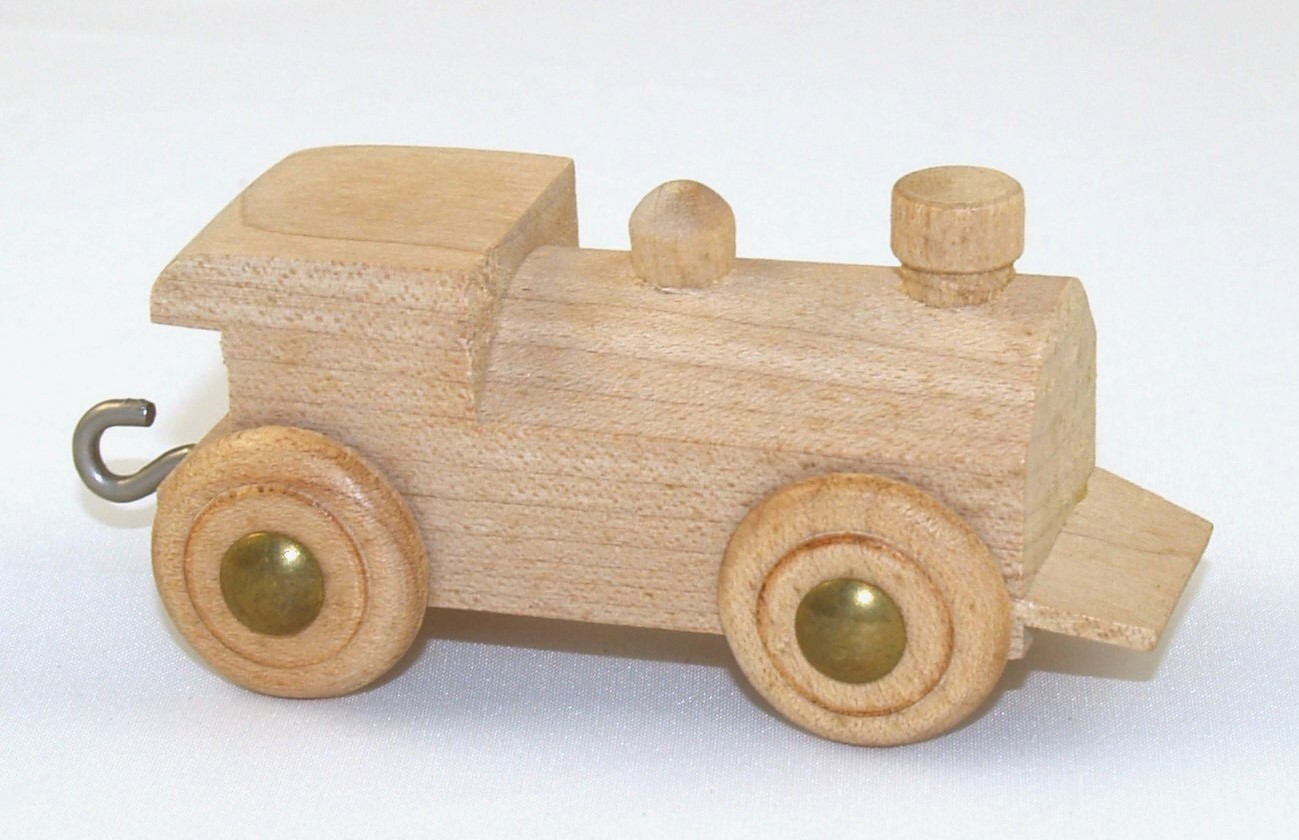 SH Loco Prototype
SH Loco Prototype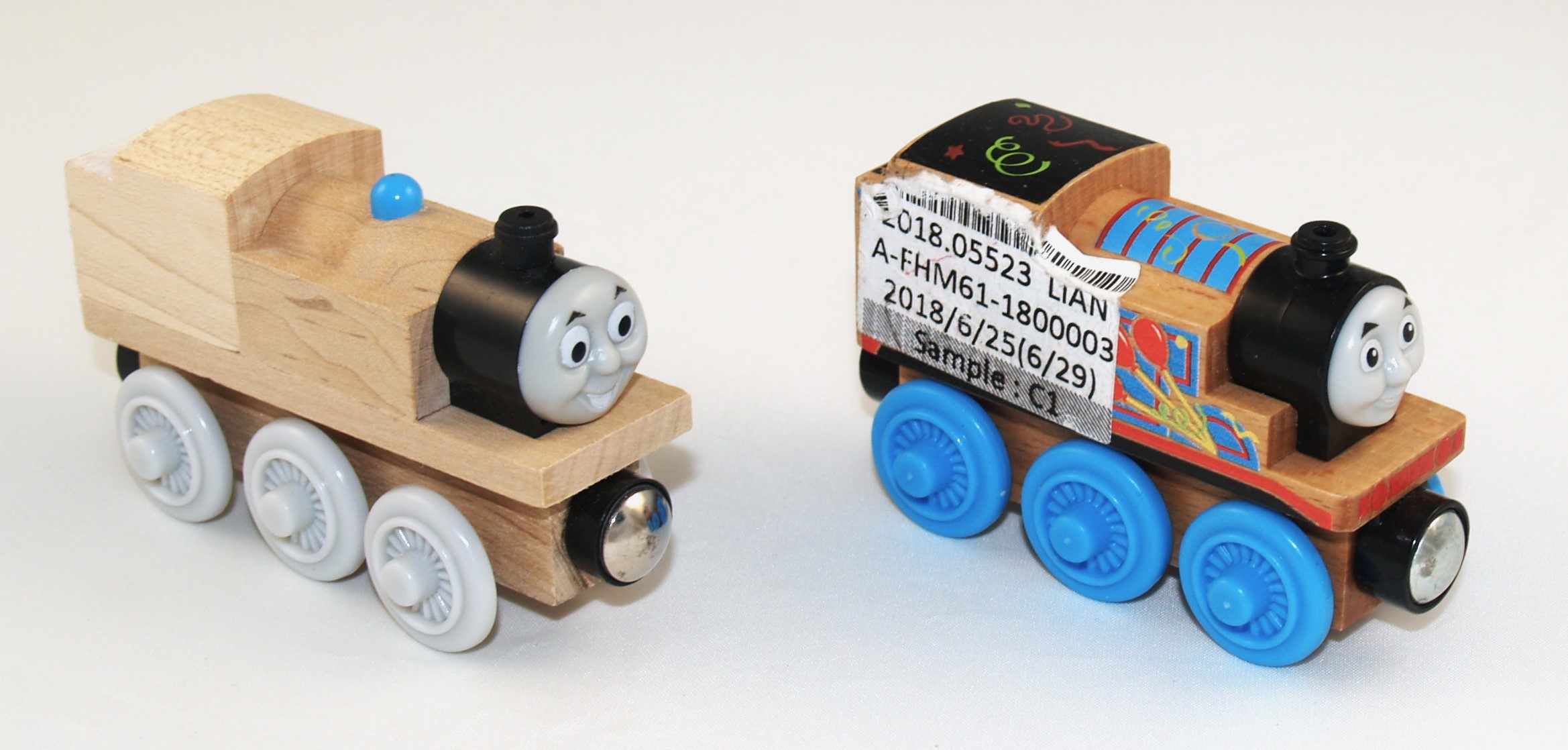 Thomas Pre-Pros
Thomas Pre-Pros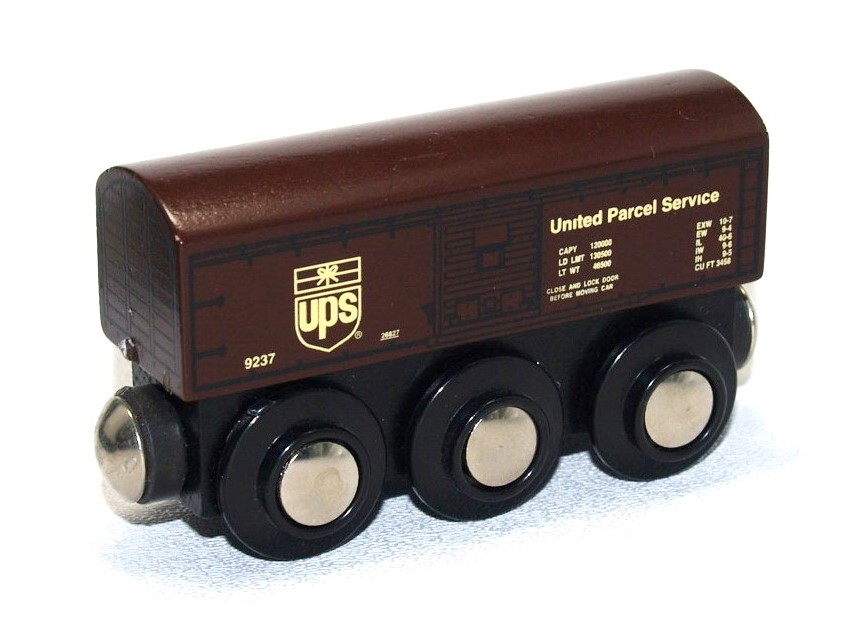 Maxim Lionel UPS Boxcar
Maxim Lionel UPS BoxcarScarce or Unusual Items
The term “rare” has become so overused in today’s world that the most common reaction to hearing or reading it, is an eye-roll. In the toy train genre, rarity itself is seldom a guarantee of impressive value. In fact, those people who buy items strictly for a potential “big pay day” in the future, will usually suffer disappointment without experiencing the joy of ownership. For those of us who are budget-challenged, finding items that few other people have in their collections or that reveal a heretofore unknown or forgotten part of toy train history, can provide a great deal of owner satisfaction. Identifying such an item can also lead to new paths of discovery, if it points to other items of a similar ilk that may still be lurking in the shadows.
For example, the 3 BRIO locomotives pictured here are notable for the BRIO stickers affixed to their “boilers”. That feature is quite unusual for this basic-style locomotive. Most other sets that include it, have the stickers affixed to a piece of rolling stock … not to the loco itself. These locos were reportedly used for low-cost or promotional sets that included only a single piece of rolling stock and a small loop of track. In addition, the combination of certain paint colors and boiler stickers for this style locomotive were reportedly exclusive to a single country or region … red for Canada, green for Germany, black for the UK. I found the black loco first and was spurred on to find other colors with boiler stickers, if they existed. My search lasted several years, and the purchases came from 3 different countries.
The 4-piece unpainted BRIO goods train shown here was reportedly only released in Germany, and may have been a short-run, retail store “rewards” item, after customers purchased other “qualifying” sets. BRIO fans will know that unpainted wooden track trains are quite “rare” for this company. The BRIO company is globally famous for toys with bright, glossy paint.
The BRIO locomotive with the numeral 40 printed in gold was a promotional gift for attendees of the 2014 Nuremberg Toy Fair, celebrating 40 years of this BRIO train genre in the German marketplace. The loco was packaged in a clear plastic baggie.
Likewise, the Maxim Enterprise coach made for General Electric (“Security Integrator Program”) may have been a promotional item given or sold at a conference or convention. Something for a parent to gift to his/her child after returning from a business trip. The possibility also exists that it was a paint sample from Maxim, once presented to the GE marketing staff for potential production. I have never seen another example in any condition.
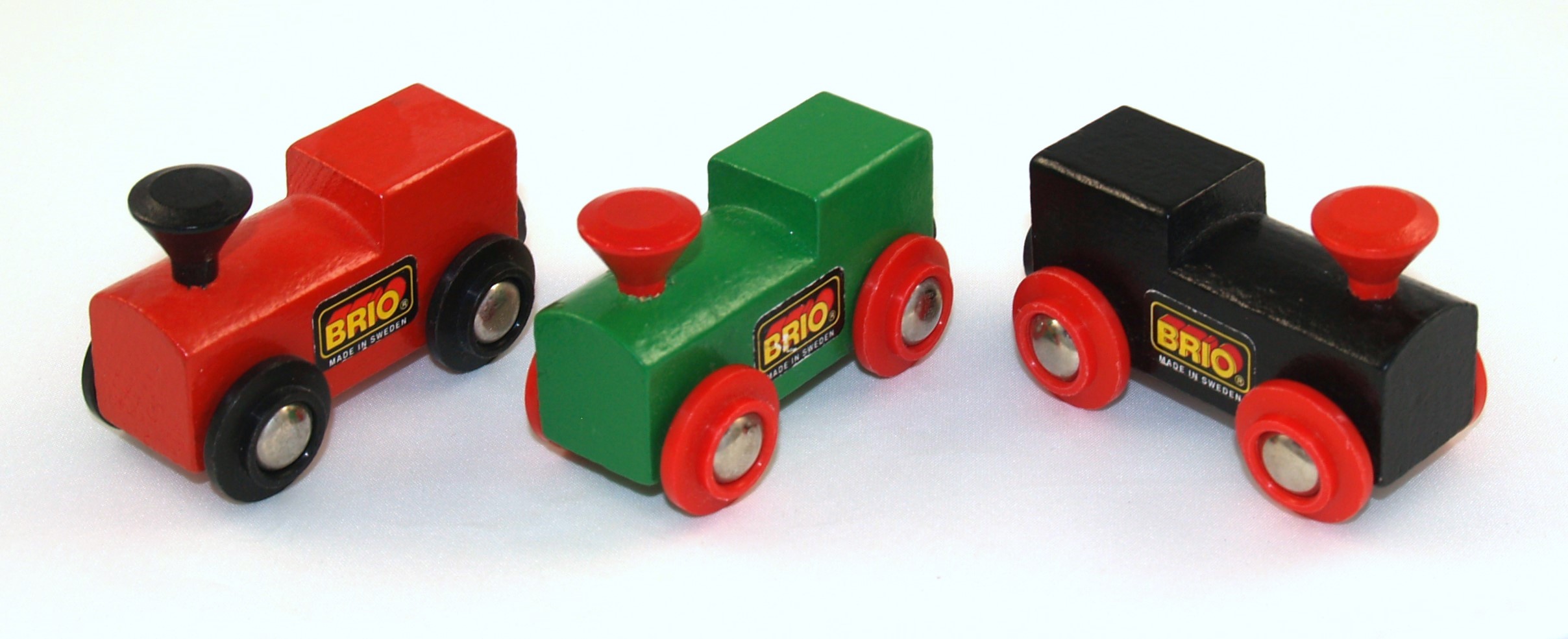 BRIO Basic Locos - Stickered
BRIO Basic Locos - Stickered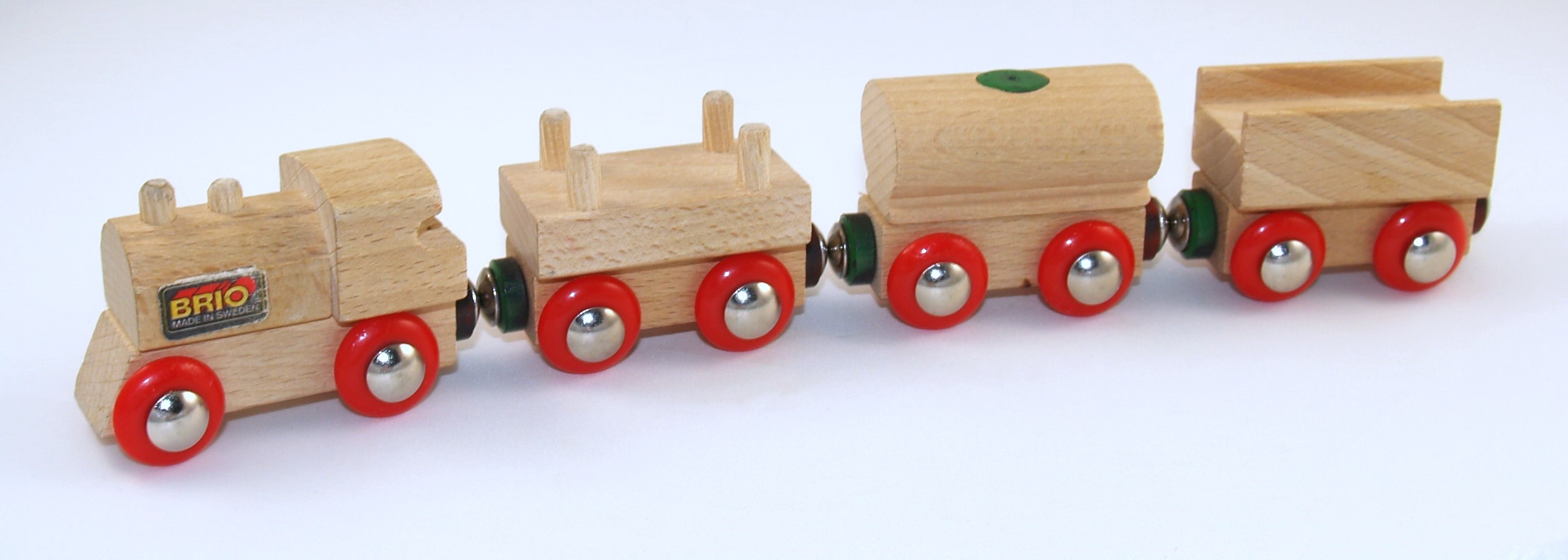 BRIO Goods Train - Unpainted
BRIO Goods Train - Unpainted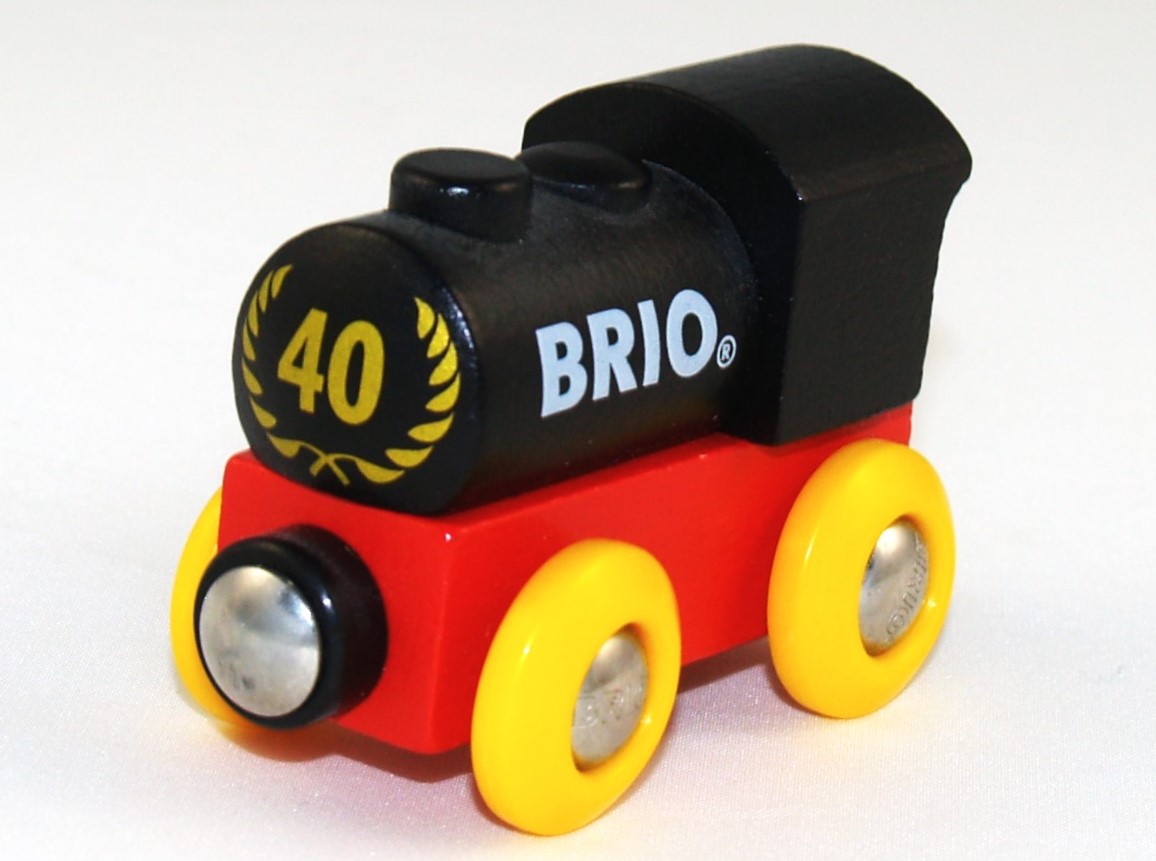 BRIO 40th Anniversary Locomotive
BRIO 40th Anniversary Locomotive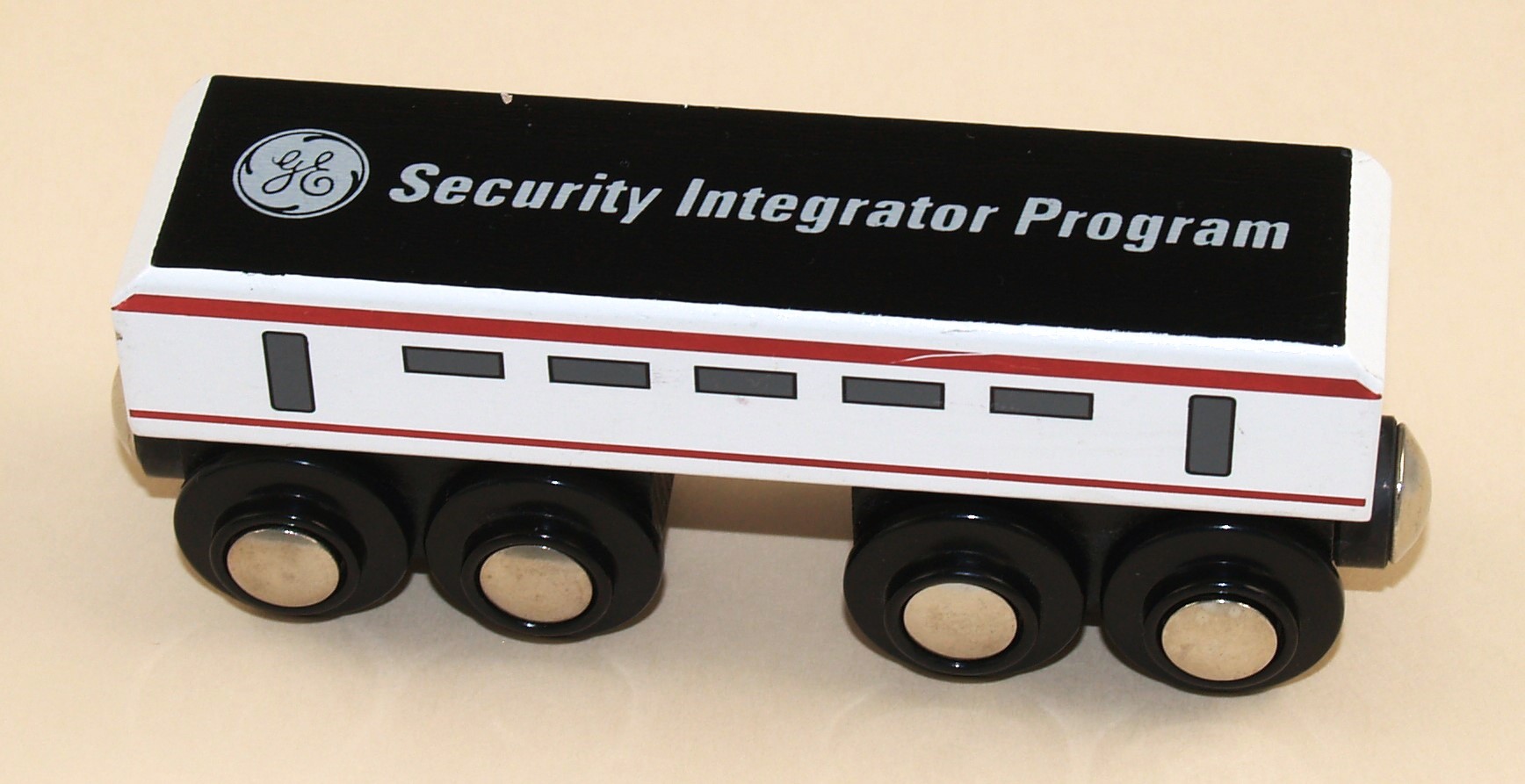 Maxim GE Promo Coach
Maxim GE Promo CoachThese low-production items are just a few examples of toy trains that can make even a modest collection or operating layout much more interesting and memorable. They can also reveal some little known, long forgotten or undocumented chapters of toy train history. Undoubtedly there are many other unusual items still “out there” … just waiting to be rediscovered.
New Tracks Modeling -
Scholarship Awards
New Tracks Modeling is an excellent organization founded by Jim Kellow, MMR offer very instructive live modeling sessions every Wednesday evening for all those who wish to improve their modeling skills. Jim has taken this program to a new level over the past two years, now offering scholarships to young high school and college bound students.
The goal of the New Track Modeling Mentoring Scholarship (NTMMS) is to help model railroaders pursue their higher education in a STEAM discipline. Each scholarship winner is awarded $2000.
This year the three scholarship winners are:
Ethan Prasad Bernstein, who just completed his junior year and is pursuing a Bachelor of Science degree in Engineering from Johns Hopkins University. Ethan is the recipient of the scholarship sponsored by the Pacific Coast Region of the NMRA.
Brock Marion Durham is pursuing a degree in Civil Engineering at The Citadel.
Robert Daniel Winter will be entering the University of Washington this Fall in pursuit of a degree in Mechanical Engineering.
Here is a video showing the presentation of these awards:
https://youtu.be/1NA0SQyxJas?si=hAQIfKoYDt9OmT6W
For more information, go to the New Tracks website: https://newtracksmodeling.com/scholarship/
The Art of Model Railroading
Model Railroading is an expansive hobby which embraces a combination of science and art. It encompasses math, physics, chemistry, electronics, technology and the art of creating realistic three dimensional landscaping and beautiful painted backdrops, or murals. It stimulates both the technical and artistic parts of your brain at the same time. There is much to learn here. I must say, I was a little intimidated by it all as a beginner, but there is no need to be. Almost everything we do in life requires a beginning, or learning, phase. There is fun and satisfaction in the journey; no need to rush to completion.
Model railroaders are teachers. They love to show off what they have done and tell people how they did it. You just have to ask. Once they get started, it's hard for them to stop. They don't mind that you might be a beginner. That just allows them to teach that much more.
The website, Building-Your-Model Railroad.com (BYMRR.com), is a comprehensive guide that provides the basics for beginners, but also provides information on the more advanced technologies, electronics and automation. It also has a large section on how to build scenery, which of course is the art of the hobby, and the focus of today's topic. Every model railroader likes certain aspects of the hobby better than others. For me, it's the scenery.
Here is a link to the section on Scenery in the BYMRR site. You may have seen it before, but even so, it's always good as a reference.
https://www.building-your-model-railroad.com/model-train-scenery.html
The Local - Newsletter for the Mid-Eastern Region of the NMRA -
September-October 2024 edition
https://acrobat.adobe.com/id/urn:aaid:sc:US:6badf0d2-9805-4f0f-b0af-01032dd3b2b6
Video of the Month - How to build a small but very impressive mountainous layout
Model Railroad Train Show in Virginia Beach
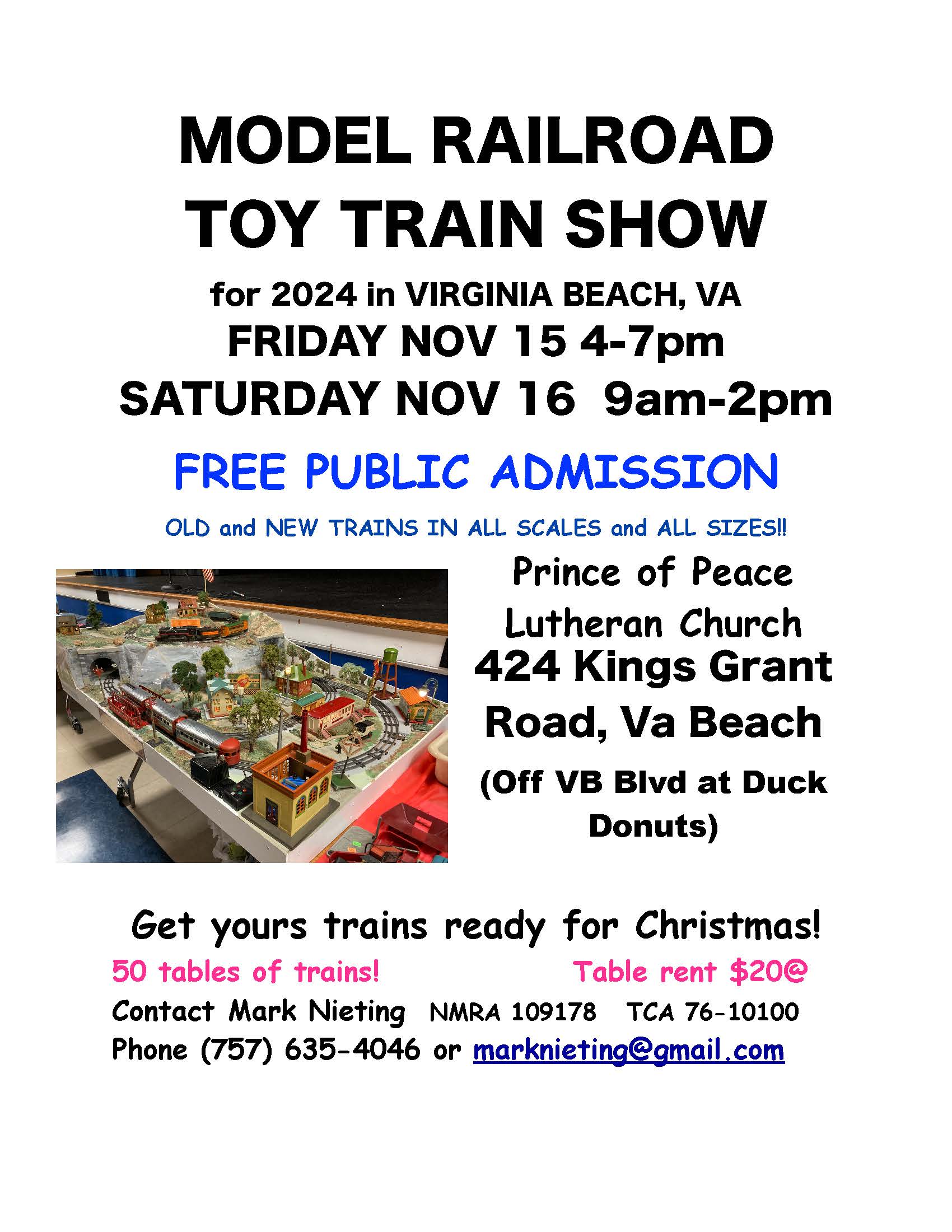
Thanks for reading "Making Tracks." Don't forget your monthly donation!
Happy Railroading!
MRMHR Team


Share this site on your favorite Social Media page!
Recent Articles
-
Making Tracks October 2025
Oct 09, 25 11:07 AM
The official newsletter of the Model Railroad Museum of Hampton Roads. -
Making Tracks September 2025
Sep 01, 25 11:01 AM
The Model Railroad Museum of Hampton Roads is a fun, educational, community center demonstrating multiple train layouts in all the different major scales. -
Working on the Railroad
Aug 26, 25 07:05 AM
Photos and descriptions of projects being done on the model railroads at the museum.
The Birth of Virginia Beach

We have created and published a new historical document on the Birth of Virginia Beach. This has been written by our historian Warren Leister after researching the era and the people involved for several years. Excepts have been published here in our newsletter previously, but the information is now available all together in a 99 page document that you can purchase in our store. It factually explores the events, the dedicated people and the interesting culture in which they lived. Pick up your copy today!
The Model Railroad Museum of Hampton Roads is a fantastic community center based on running, operating and even building your own model railroads! There's something for every age here.
Learn about the real history of this area and how important it was in the building of America. Watch how railroads were built, the people involved, where America's roots were formed.
As they build their own railroads, students will be learning about science, electronics, architecture, technology, engineering, mathematics, and the art of 3 dimensional model landscaping. They can earn rewards for completing projects and winning contests.
Try to solve yardmaster problems on a switching layout like getting the lumber from the forest to the furniture store, by way of the saw mill and the lumber yard.
Run your train around blockades and other trains to get to the station on time without speeding or crashing.
Play railroad monopoly using model railroads. Winner is the one who can collect the most cars into his yard within an hour.
There will be programs for autistic and special needs kids, disabled adults and veterans.
School tours. Holiday Shows. Library and video rooms. Even youngsters will have their own wooden models to enjoy. There are classes and hands-on clinics for adults. Learn how to get started in the hobby. Or just enjoy the fun.
Everybody loves trains and this will prove it! Just click on the either the blue DONATE button below to make it happen...
PayPal Giving Fund:
No Credit Card Fees
OR...
Charitable Donations through PayPal, Credit or Debit cards:
(Opt in or out of paying credit card fees)
Get Updates and Special Offers in
the MRMHR Newsletter:
Making Tracks
Sign Up Here...
The official newsletter for the Model Railroad Museum of Hampton Roads

